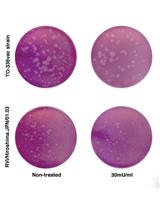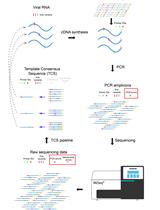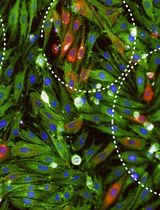- EN - English
- CN - 中文
Time-of-addition and Temperature-shift Assays to Determine Particular Step(s) in the Viral Life Cycle that is Blocked by Antiviral Substance(s)
改变药物添加时间及变温分析实验确定抗病毒物质所作用的病毒生命周期中的步骤
(*contributed equally to this work) 发布: 2018年05月05日第8卷第9期 DOI: 10.21769/BioProtoc.2830 浏览次数: 10350
评审: Vamseedhar RayaproluKristin ShinglerSmita Nair
Abstract
Viruses infect their host cells to produce progeny virus particles through the sequential steps of the viral life cycle, such as viral attachment, entry, penetration and post-entry events. This protocol describes time-of-addition and temperature-shift assays that are employed to explore which step(s) in the viral life cycle is blocked by an antiviral substance(s).
Keywords: Viral life cycle (病毒生命周期)Background
Viruses are obligate intracellular parasites that hijack host cell machineries to replicate their own genome. The viral life cycle proceeds through the attachment (binding) of an infectious viral particle (virion) to the surface of the host cell and its penetration (internalization, fusion) into intracellular compartments, where virion uncoating (disassembly) takes place, followed by viral genome transcription/replication, viral protein synthesis and virion assembly, which eventually results in the production and release of progeny virions from the infected cell (Scheel and Rice, 2013).
To explore which step(s) of the viral lifecycle is blocked by an antiviral substance, time-of-drug addition experiments are performed. In brief, an antiviral substance is added to the virus and/or host cells at different time points relative to viral inoculation to the cells (Chen et al., 2017): (1) Pre-treatment of the cells with an antiviral substance before viral inoculation examines whether the substance could block the viral receptor to inhibit viral attachment to the host cells or if it could induce production of antiviral host factors, such as interferon. (2) Pre-treatment of virus followed by inoculation of the treated virus to the cells examines the virucidal or neutralizing activity of the antiviral substance. (3) Co-treatment of cells and virus during virus inoculation examines the antiviral effect on the virus entry steps including virucidal (neutralizing) activity and blockade of viral attachment and penetration to the cells. (4) Treatment of virus-infected cells during the entire post-inoculation period examines the antiviral effect during the post-entry steps, such as genome translation and replication, virion assembly and virion release from the cells. In addition, temperature-shift assay can differentiate between (5) antiviral activity against attachment that occurs at both 37 °C and 4 °C and (6) antiviral activity against penetration (internalization and/or fusion) that occurs only at 37 °C. An interesting example is that secreted phospholipase A2 obtained from bee venom inhibits penetration of human immunodeficiency virus (HIV) virion without inhibiting virion attachment to the cell surface (Fenard et al., 1999).
In this article, we describe procedures of time-of-addition and temperature-shift assays for the mechanistic analyses of antiviral substances using a fluorescent antibody (FA) method, which have been reported elsewhere (Wahyuni et al., 2013; Adianti et al., 2014; Ratnoglik et al., 2014; El-Bitar et al., 2015; Apriyanto et al., 2016; Chen et al., 2017). Alternative titration methods, such as plaque assay, 50% tissue culture infectious dose (TCID50) assay and quantitative PCR (qPCR and qRT-PCR), are also used to determine viral titers as described elsewhere.
Materials and Reagents
- Disposable tips
- 100 mm culture dish (Corning, Falcon®, catalog number: 353003 )
- 24-well culture plate (Corning, Falcon®, catalog number: 353047 )
- Cover slip (13 mm in diameter; Matsunami Glass, catalog number: C013001 )
- 1.5 ml Microcentrifuge tube (FUKAEKASEI and WATSON, catalog number: 131-715C )
- Disposable serological pipette
- Huh7it-1 cells (Apriyanto et al., 2016)
- Viruses (Chen et al., 2017):
- Hepatitis C virus (HCV; J6/JFH-1 strain)
- Dengue virus type 2 (DENV-2; Trinidad 1751 strain)
- Japanese encephalitis virus (JEV; Nakayama strain)
- Influenza A virus (FLUAV; A/Udorn/307/72[H3N2])
- Sendai virus (SeV; Fushimi strain)
- Herpes simplex virus type 1 (HSV-1; CHR3 strain)
- Coxsackievirus B3 (CV-B3; Nancy strain)
- Hepatitis C virus (HCV; J6/JFH-1 strain)
- Crushed ice
- 4% paraformaldehyde (Wako Pure Chemical Industries, catalog number: 163-20145 )
- Triton X-100 (Wako Pure Chemical Industries, catalog number: 169-21105 )
- Bovine serum albumin (BSA; Wako Pure Chemical Industries, catalog number: 015-21274 )
- Primary antibodies (Chen et al., 2017): Antibodies against viruses, such as HCV, DENV-2, JEV, FLUAV, SeV, HSV-1 and CV-B3
- Secondary antibodies:
- FITC-conjugated goat anti-human IgG (MEDICAL & BIOLOGICAL LABORATORIES, catalog number: 104AG )
- Alexa Flour488-conjugated goat anti-mouse IgG (Thermo Fisher Scientific, Invitrogen, catalog number: A-11001 )
- Alexa Flour488-conjugated goat anti-rabbit IgG (Thermo Fisher Scientific, Invitrogen, catalog number: A-11008 )
- FITC-conjugated goat anti-human IgG (MEDICAL & BIOLOGICAL LABORATORIES, catalog number: 104AG )
- Hoechst 33342 (Thermo Fisher Scientific, catalog number: H3570 )
- Vectashield solution (Vector Laboratories, catalog number: H-1000 )
- Trypsin-EDTA solution (Wako Pure Chemical Industries, catalog number: 209-16941 )
- High glucose Dulbecco’s modified Eagle’s medium (Wako Pure Chemical Industries, catalog number: 044-29765 )
- MEM with non-essential amino acids (Thermo Fisher Scientific, GibcoTM, catalog number: 10370-021 )
- Fetal bovine serum (FBS; Biowest, catalog number: S1820 )
- Penicillin-Streptomycin solution (Wako Pure Chemical Industries, catalog number: 168-23191 )
- Sodium chloride (NaCl; Wako Pure Chemical Industries, catalog number: 191-01665 )
- Potassium chloride (KCl; Wako Pure Chemical Industries, catalog number: 163-03545 )
- Sodium phosphate dibasic dodecahydrate (Na2HPO4·12H2O; Sigma-Aldrich, catalog number: 71649 )
- Potassium dihydrigen phosphate (KH2PO4; Wako Pure Chemical Industries, catalog number: 169-04245 )
- Sodium citrate dehydrate (Sigma-Aldrich, catalog number: W302600 )
- Citric acid (Wako Pure Chemical Industries, catalog number: 030-05525 )
- Culture medium (see Recipes)
- 10x phosphate-buffered saline without Ca2+ and Mg2+ (PBS[-]) and 1x PBS(-) (see Recipes)
- Citrate buffer (see Recipes)
Equipment
- Biosafety cabinet (e.g., Panasonic, model: MHE-S1301A2 )
- CO2 incubator (e.g., Panasonic, model: MCO-20AIC )
- Autoclave (e.g., TOMY SEIKO, model: SX-500 )
- Refrigerated tabletop centrifuge (e.g., Eppendorf, model: 5424 )
- Micropipette (Gilson, P20, P200, P1000)
- Hemocytometer (e.g., Erma, catalog number: 03-303-1 )
- -80 °C freezer (e.g., PHC, model: MDF-384 )
- Inverted microscope (e.g., Olympus, model: CKX53 )
- Fluorescent microscope (e.g., Carl Zeiss, model: LSM700 )
Procedure
文章信息
版权信息
© 2018 The Authors; exclusive licensee Bio-protocol LLC.
如何引用
Aoki-Utsubo, C., Chen, M. and Hotta, H. (2018). Time-of-addition and Temperature-shift Assays to Determine Particular Step(s) in the Viral Life Cycle that is Blocked by Antiviral Substance(s). Bio-protocol 8(9): e2830. DOI: 10.21769/BioProtoc.2830.
分类
微生物学 > 抗微生物试验 > 抗病毒试验
您对这篇实验方法有问题吗?
在此处发布您的问题,我们将邀请本文作者来回答。同时,我们会将您的问题发布到Bio-protocol Exchange,以便寻求社区成员的帮助。
Share
Bluesky
X
Copy link














